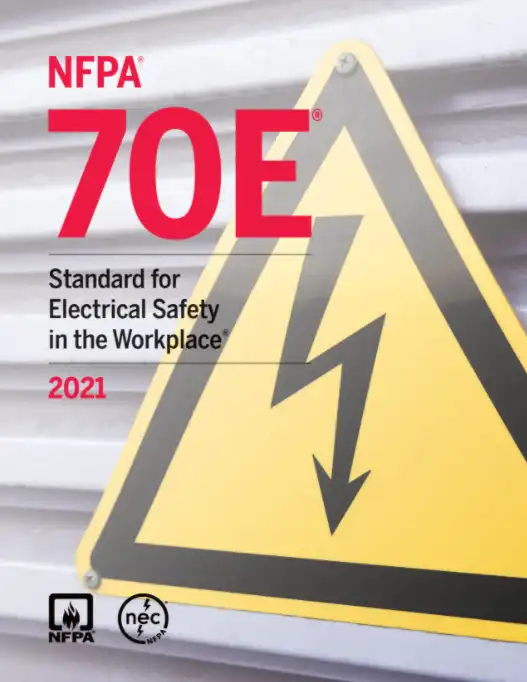NFPA 70E States That Equipment Should Be De-Energized Unless Hazardous
By R.W. Hurst, Editor

Arc Flash Training - CSA Z462 Electrical Safety
Our customized live online or in‑person group training can be delivered to your staff at your location.

- Live Online
- 6 hours Instructor-led
- Group Training Available
Download Our OSHA FS3529 Fact Sheet – Lockout/Tagout Safety Procedures

- Learn how to disable machines and isolate energy sources safely
- Follow OSHA guidelines for developing energy control programs
- Protect workers with proper lockout devices and annual inspections
NFPA 70E states that equipment should be de-energized unless justified by risk; include lockout/tagout, arc flash analysis, energized work permits, PPE selection, and OSHA-compliant procedures to control shock hazards during maintenance and troubleshooting.
What Does 'NFPA 70E States That Equipment Should Be De-Energized Unless' Mean?
Energized work is allowed only if de-energizing is infeasible or increases hazard, with permits, LOTO, PPE, and RA.
✅ Document an Energized Electrical Work Permit (EEWP).
✅ Perform shock and arc-flash risk assessment; set boundaries.
✅ Apply LOTO unless justified; use PPE and safe practices.
NFPA 70E states that equipment should be de-energized unless de-energizing the equipment introduces additional hazards, is infeasible due to the nature of the work, or interrupts critical processes such as life support systems or continuous operations.
NFPA 70E is a critical standard for ensuring electrical safety in the workplace. It mandates that electrical equipment should be de-energized before any work is performed on it. However, there are specific conditions under which this equipment can remain energized. This article explores these conditions, the emphasis on de-energizing equipment, required procedures when de-energizing is not possible, the exceptions to the rule, and the risks associated with working on energized equipment. For a concise overview of scope and intent, see the NFPA 70E introduction for additional context.
What Are the Specific Conditions Under Which NFPA 70E Allows Equipment to Remain Energized?
NFPA 70E permits equipment to remain energized under certain conditions. These include situations where de-energizing the equipment introduces additional hazards or is infeasible due to the nature of the work. Examples include when de-energizing would interrupt life support systems, compromise the integrity of critical processes, or when equipment is part of a continuous operation. Additionally, if de-energizing creates a greater hazard, such as the shutdown of hazardous location ventilation, the equipment may remain energized. These scenarios are further summarized in the NFPA 70E overview to help practitioners interpret when energized work may be permitted.
FREE EF Electrical Training Catalog
Download our FREE Electrical Training Catalog and explore a full range of expert-led electrical training courses.

- Live online and in-person courses available
- Real-time instruction with Q&A from industry experts
- Flexible scheduling for your convenience
Why Does NFPA 70E Emphasize De-Energizing Equipment as the Preferred Method for Ensuring Electrical Safety?
De-energizing equipment is emphasized because it significantly reduces the risk of electrical incidents. When equipment is de-energized, the likelihood of arc flash hazards, electric shock, and other injuries is minimized. Creating an electrically safe work condition through de-energization is the most effective way to protect workers. NFPA 70E prioritizes this approach to prevent exposure to live electrical parts and incident energy that can cause severe harm. For clarity on establishing an electrically safe work condition, consult this detailed guide on what constitutes an electrically safe condition before beginning any task.
What Procedures Must Be Followed If Equipment Cannot Be De-Energized According to NFPA 70E?
If equipment cannot be de-energized, NFPA 70E mandates strict procedures to ensure safety. Workers must perform a risk assessment to identify potential hazards and determine appropriate protective measures. This includes establishing a limited approach boundary to keep unqualified persons at a safe distance, using lockout tagout procedures to control hazardous energy, and ensuring that only qualified persons are performing energized work. Additionally, appropriate personal protective equipment (PPE) must be worn to mitigate the risks associated with working on energized equipment. Guidance on boundaries, labeling, and PPE selection is distilled in the NFPA 70E arc flash requirements to support compliant work planning.
How Does NFPA 70E Define the Exceptions to the Requirement for De-Energizing Equipment?
NFPA 70E defines exceptions to de-energizing equipment by identifying scenarios where de-energization is not practical or increases risk. These exceptions include work on equipment that is part of a continuous process, where de-energizing would result in a greater hazard, or when the equipment is integral to life support systems or critical infrastructure. The standard requires that any work performed under these exceptions must adhere to strict safety protocols to ensure the protection of workers. For practical implementation examples and decision-making considerations, refer to resources where NFPA 70E provides practical guidance across diverse operating environments.
What Are the Potential Risks and Safety Considerations Associated with Working on Energized Equipment Under NFPA 70E Guidelines?
Working on energized equipment presents significant risks, including the potential for arc flash hazards, electric shock, and severe burns. NFPA 70E outlines safety considerations to mitigate these risks, such as performing a thorough risk assessment, using appropriate PPE, and ensuring that only qualified persons are involved in performing energized work. Incident energy levels must be calculated to determine the appropriate protective measures. Additionally, maintaining clear communication and using proper tools and equipment are essential for minimizing the dangers of energized work. A comprehensive framework for hazard analysis and controls is outlined in the NFPA 70E Standard for Electrical Safety in the Workplace to reinforce safe energized work practices.
While NFPA 70E emphasizes the importance of de-energizing equipment to ensure electrical safety, it also provides guidelines for situations where de-energizing is not feasible. By following these guidelines, performing risk assessments, and using appropriate protective measures, workers can safely manage the inherent risks of working on energized electrical equipment. For current interpretations and updates, review the NFPA 70E 2024 edition highlights to align programs with the latest requirements.







